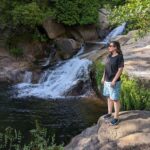(Last updated on 12/05/2025)
With over fifty castles just in Badajoz province, Extremadura is an excellent travel destination for castle lovers. Castillo de Alange, situated in the Sierra Grande – Tierra de Barros area, is a great day trip from Mérida, as you can reach it in under thirty minutes from the region’s capital.
In this short guide, I’ve included a general overview, practical info and personal tips to help you plan your trip and make the most of your visit to Castillo de Alange.

Castillo de Alange is a medieval defensive castle set atop Cerro de la Culebra, a rocky hill standing at 485 metres over sea level by the Alange reservoir. The castle, also known as Castillo de la Culebra after the hill, was built in the ninth century by the Moors over a former Roman fortress. In the thirteenth century the Christians took over and the castle was inhabited until its abandonment in the sixteenth century.
Castillo de Alange today
The castle witnessed numerous battles throughout the centuries and only the keep, and remains of two other towers, two gates, part of the walls and two cisterns have survived. Everything but for the Moorish cisterns dates from the Christian period.
The castle is free-access and free to visit. You can’t access the keep inside but you’re free to roam about the hill and enjoy the views.

Tip: Don’t forget your binoculars. The castle area is a great place for birdwatching!
Visiting Castillo de Alange
The castle can only be accessed on foot following the path starting in Calle Castillo, on the western side of the village. The location is not particularly accessible or health and safety compliant (particularly the south-facing slope), so I wouldn’t recommend it to people with knee, hip or general agility problems. And, although I’ve seen people walking up to the castle with children on the south-facing slope, I wouldn’t personally recommend it for small children either.


When to go: the route to Castillo de Alange is not recommended for the summer months. I’ve done this route several times at different times of the year. These are my weather-related observations, based on my own experience: late March is pleasantly mild, mid-September is way too hot, and early January is cool and breezy.
How to get to Castillo de Alange
The starting point of the route to the castle is at the end of Calle Castillo. You can either walk there from the centre of Alange (as a reference, the Oficina de Turismo is under fifteen minutes away on foot), or drive. I’ve been there several times at different times of the year and there’s always free on-site parking.
Walk up the paved road and continue along the path until it splits. Then you can choose to walk up either (a) the south-facing slope (Camino Puerta del Sol), stopping at a cistern and a viewpoint, or (b) the north-facing slope (Camino Umbría), stopping at another cistern. The walk up and down the castle should take under two hours in total.


My preferred option is to walk up the south-facing slope and down the north-facing slope, as per the official route.
Castillo de Alange: highlights
Viewpoint by Puerta del Sol
About halfway up to the castle and just before the second gate, called Puerta del Sol, you’ll find a little viewpoint. It’s a good place for a quick stop before starting the hardest ascent. The viewpoint offers fantastic views to the east of Alange, the nearby sierras and the reservoir.

Keep
The imposing keep is the main reference point throughout the route and marks the end of the ascent. The hill offers a 360-degree view of the surrounding area and, if you lean against each side of the quadrangular keep, you’ll enjoy four unique views in four different directions.

Views from the castle
The views from Castillo de Alange are far-reaching in all directions. These are some of the things and places you’ll be able to spot (without binoculars) from the hill:

To the west: the village of Torremejía and the Sierra de San Serván

To the north: the river Matachel and the villages of La Zarza and Don Álvaro

To the east: the village of Alange and the Sierra de Peñas Blancas

To the south: Alange reservoir
This content is protected by copyright and belongs exclusively to Irene Corchado Resmella. To know exactly what this means, read the 'Copyright' section in the Website terms of use.

Irene Corchado Resmella
Hi! I’m Irene (/ee-REH-neh/). Long since settled in the UK, I explore my Spanish home region of Extremadura with an inquisitive mind, a sharp eye, and the duality that comes with being both a local and a visitor. Then I write about it here to help you discover this beautiful yet overlooked part of Spain. If you have any questions after reading this article, submit a comment below! Read more about me.
